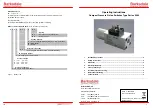
2-17
z
When the number of multicast groups a port has joined reaches the maximum number configured,
the system deletes all the forwarding entries persistent to that port from the IGMP Snooping
forwarding table, and the hosts on this port need to join the multicast groups again.
z
If you have configured static or simulated joins on a port, however, when the number of multicast
groups on the port exceeds the configured threshold, the system deletes all the forwarding entries
persistent to that port from the IGMP Snooping forwarding table and applies the static or simulated
joins again, until the number of multicast groups joined by the port comes back within the
configured threshold.
Configuring Multicast Group Replacement
For some special reasons, the number of multicast groups that can be joined on the current switch or
port may exceed the number configured for the switch or the port. In addition, in some specific
applications, a multicast group newly joined on the switch needs to replace an existing multicast group
automatically. A typical example is “channel switching”, namely, by joining a new multicast group, a
user automatically switches from the current multicast group to the new one.
To address such situations, you can enable the multicast group replacement function on the switch or
certain ports. When the number of multicast groups joined on the switch or a port has joined reaches
the limit:
z
If the multicast group replacement feature is enabled, the newly joined multicast group
automatically replaces an existing multicast group with the lowest address.
z
If the multicast group replacement feature is not enabled, new IGMP reports will be automatically
discarded.
Configuring multicast group replacement globally
Follow these steps to configure multicast group replacement globally:
To do...
Use the command...
Remarks
Enter system view
system-view
—
Enter IGMP Snooping view
igmp-snooping
—
Enable multicast group
replacement
overflow-replace
[
vlan
vlan-list
]
Required
Disabled by default
















































